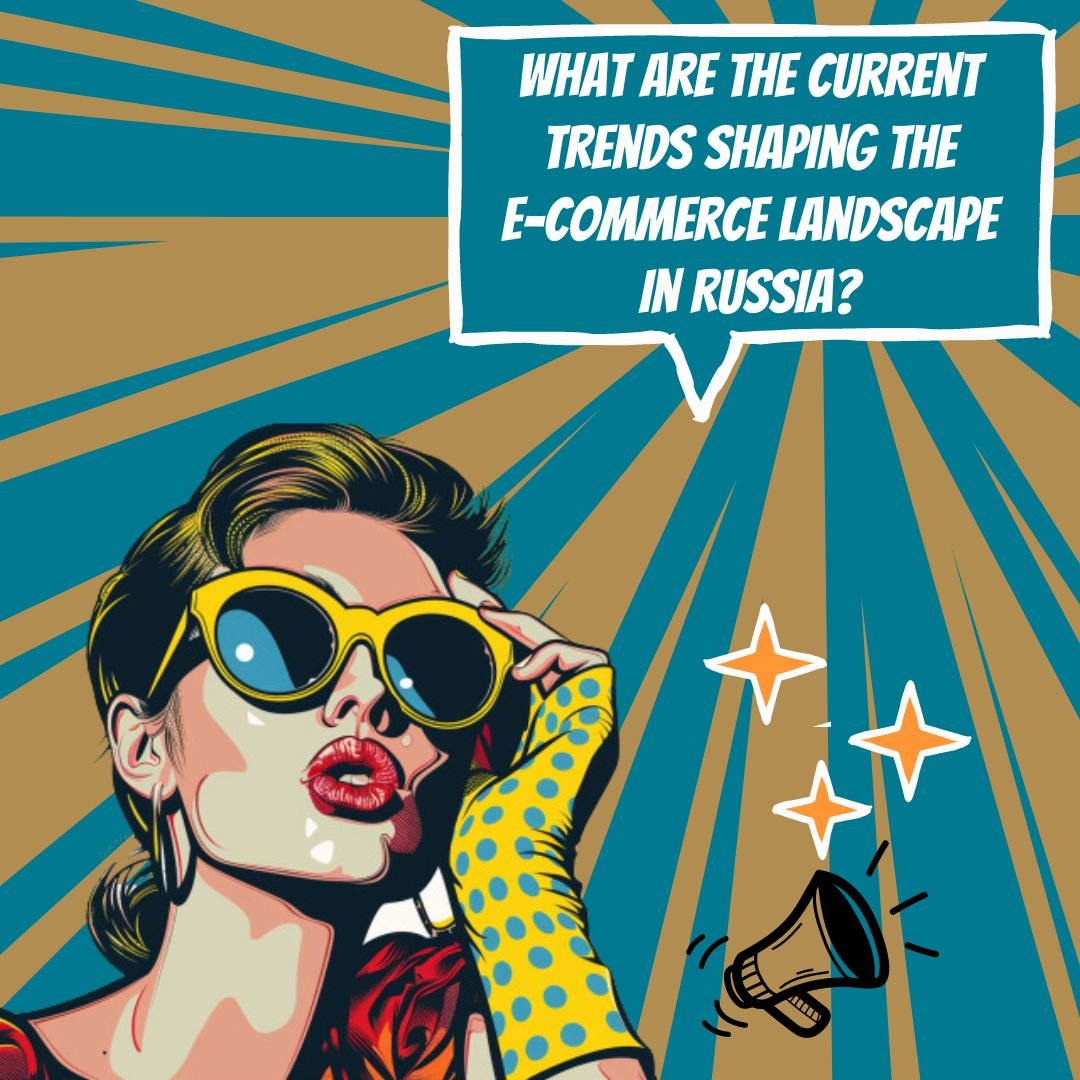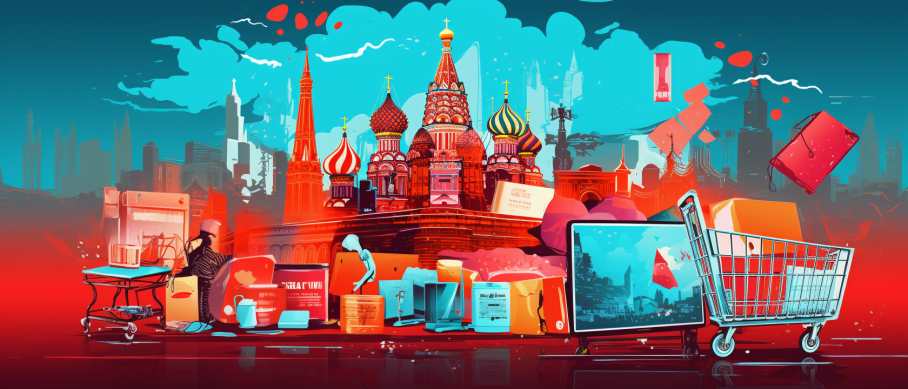Key Takeaways
✅ Rapid Growth and Internet Penetration: The Russian e-commerce scene is flourishing, with an expected value of $33.3 billion by 2021. Internet usage is soaring, contributing to a robust 11.6% CAGR through 2025. To capitalize on this upward swing, businesses need to align with the digital curve and consider the broadening online audience.
✅ Mobile Commerce and Social Media: Mobile shopping isn't just growing; it's a cornerstone of modern Russian e-commerce, preferred over traditional methods. Social networks, particularly VKontakte and Instagram, are pivotal in influencing buyers. Prioritizing a mobile-first approach and integrating social media can drive significant e-commerce traction.
✅ Localization and Payment Preferences: Successful entry into the Russian market hinges on localization. Offering customer service in Russian, accepting local payment methods like cash on delivery, and addressing unique consumer likes can set a business apart. E-wallets and bank cards are also in the mix, so inclusivity in payment options is key.

Introduction
Ever wondered how big the online shopping world really is in Russia? We're talking about an e-commerce landscape that's expanding so fast it might just leave you at the starting line if you don't catch up. Understanding the Russian e-commerce market – its size, its explosive growth, and its untapped potential – could be your golden ticket to success.
From mobile commerce taking the spotlight to the intricate web of social commerce shaping purchasing decisions, this guide is your one-stop-shop for everything you need to know. We'll peer into the complexities of payment preferences, glide through the maze of logistics and deliveries, and dive deep into the heart of what Russian consumers really want.
Navigating this domain is no small feat. Don't you want in on the secrets that could turbo-charge your return on ad spend (ROAS) or rocket your return on investment (ROI)? Well, hold tight because we’re going to provide you with not just the stats and facts, but also actionable insights and cutting-edge strategies to make your e-commerce venture soar. Get ready for a crash course in maximizing revenue and staying ahead in the vibrant Russian e-commerce bazaar.

Top Statistics
| Statistic | Insight |
|---|---|
| 2021 Projected Market Value: Russia’s e-commerce market is set to hit $31.81 billion. (Source: Insider Intelligence) | This figure signals not just growth but a surging demand for online shopping platforms in a maturing digital economy. |
| 2020 Market Growth: A significant expansion of 30% to $25.4 billion. (Source: AKIT) | This robust growth reflects how consumers in Russia are quickly adapting to the convenience of online purchases. |
| Mobile Commerce: Takeover with 55% of e-commerce sales. (Source: eMarketer) | The dominance of mobile transactions stresses the need for businesses to optimize for mobile to stay relevant and accessible. |
| 2025 Market Projection: An anticipated leap to $49.62 billion. (Source: Insider Intelligence) | Such a increase paints a picture of a highly attractive investment landscape for e-commerce initiatives. |
| Popular Categories: Electronics, clothing, and home appliances lead in online purchases. (Source: DataReportal) | Identifying top-performing sectors can guide retailers to better target their online product offerings. |
Overview of the Russian E-commerce Market
With an immense market size and growth potential, Russian e-commerce is a fertile ground for both local and international online retailers. As of recent years, the sector has seen a significant surge in activity, thanks in part to technological advancements and changing consumer behaviors. Insight into this market is not just valuable; it's essential for businesses aiming to thrive in this digital commerce space. Keeping a finger on the pulse of Russian consumer trends and preferences is not just beneficial; it's crucial for tailoring the right strategy.

Key Trends in Russian E-commerce
One of the most notable shifts in the Russian e-commerce landscape is the rise of mobile commerce, with a considerable number of Russian consumers opting to shop using their smartphones. This change emphasizes the need for mobile-optimized shopping experiences. Additionally, social commerce is gaining traction, with platforms like Instagram and VKontakte becoming popular venues for product discovery and purchase. The allure of global brands has led to a remarkable growth in cross-border e-commerce, signaling opportunities for foreign businesses looking to tap into this market.
Payment Preferences in Russia
Even as e-commerce evolves, cash on delivery remains a significant payment method, speaking to a lingering trust barrier with online transactions. However, there's no denying the growing acceptance of digital payment options such as e-wallets and mobile payments, driven by the younger, tech-savvy demographic. Amidst this digital shift, security concerns remain front and center, with consumers increasingly valuing the safeguarding of their personal and financial information.
Logistics and Delivery in Russia
Russia's vast and varied landscape presents unique challenges in logistics and delivery, particularly in remote areas. Despite these obstacles, consumer expectations are high, with a preference for popular delivery options that offer convenience and reliability. The impact of delivery speed and reliability on customer satisfaction cannot be overstated, making fast and reliable delivery services critical for fostering customer loyalty.

Consumer Preferences in Russia
Understanding consumer preferences in product categories and behaviors is pivotal for e-commerce success. Russians are showing clear preferences for certain product categories, with technology, fashion, and home goods leading the pack. Shoppers are also influenced by discounts, detailed product reviews, and extensive product information, all of which can sway their purchasing decisions. Catering to these behaviors, alongside providing a localized shopping experience with language and currency considerations, is integral for e-commerce platforms seeking to capture and retain the Russian market's attention.
AI Marketing Engineers Recommendation
Recommendation 1: Utilize Mobile Optimization Strategies: In 2021, mobile commerce (or m-commerce) in Russia represented approximately 36% of the total e-commerce market, showing a steady growth trend. Companies targeting the Russian e-commerce space must ensure that their websites and online platforms are mobile-friendly, with fast loading times, and one-click checkout processes. Providing a seamless mobile shopping experience can significantly increase customer satisfaction and conversion rates in Russia's rapidly expanding mobile user base.
Recommendation 2: Leverage Social Media and Influencer Collaboration: Social media plays a pivotal role in Russian consumer lifestyles, with platforms like VKontakte (VK), Odnoklassniki, and Instagram shaping buying behaviors. In 2022, 74% of Russian internet users were influenced by social media ads when making a purchase decision. Creating strategic partnerships with local influencers and maintaining a strong, authentic social media presence can enhance brand recognition and trust, driving sales and fostering customer loyalty in the long term.

Recommendation 3: Implement AI-Powered Personalization Tools: The use of artificial intelligence in crafting personalized shopping experiences has proven effective globally, and Russia is no exception. Personalization tools can analyze consumer behavior, predict preferences, and deliver tailored recommendations and promotions. As the Russian e-commerce market grows more competitive, integrating AI-based personalization in your e-commerce strategy could lead to a 10-15% increase in revenue by improving customer engagement and retention.
Relevant Links
- AI in E-commerce: Transforming Online Shopping
- SEO and Conversion Rate: The Winning Combo for E-commerce
- E-commerce Marketing: Strategies for Global Reach
- Top Digital Marketing Trends: What's Next?
Conclusion
E-commerce in Russia presents a dynamic frontier brimming with opportunities. As we've seen, the market's robust growth coupled with the Russian appetite for mobile and social commerce is reshaping the retail landscape. Companies who want to thrive must harness these trends in consumer preferences, which are strongly influenced by local habits, like the reliance on cash on delivery, though digital payment options are on the rise.

But engaging with this vast market isn't without its hurdles. Addressing logistical challenges is critical given Russia's expansive geography – the speed and reliability of delivery remain paramount for customer satisfaction. Similarly, businesses can't ignore the demand for secure payment options, a top concern for Russian shoppers.
Furthermore, diving into product preferences and shopping behavior uncovers the necessity for a localized approach. Understanding these aspects can spell the difference between a successful and an ill-fitting e-commerce strategy. As the sector evolves, staying ahead means being responsive to these consumer patterns and ensuring a tailored shopping experience.
Reflect on this: How will your business adapt to these insights? Are you prepared to navigate the complexities and tap into the potential of the Russian e-commerce scene? Remember, the landscape is ever-changing, and those who keep a close eye on the shifts will be best positioned to succeed. Your move, in this fascinating game of digital commerce, could define your business’s success in Russia's promising market.

FAQs
Question 1: What is the current state of e-commerce in Russia?
Answer: E-commerce in Russia has experienced significant growth in recent years, with a market size of approximately $37 billion in 2020. The sector is expected to continue expanding, driven by factors such as increasing internet penetration, a growing middle class, and a shift towards online shopping due to the COVID-19 pandemic.
Question 2: Who are the major players in the Russian e-commerce market?
Answer: The Russian e-commerce market is dominated by several major players, including Wildberries, Ozon, Yandex Market, AliExpress Russia, and M.Video-Eldorado Group. These platforms account for a significant share of the market and offer a wide range of products and services.
Question 3: What are the most popular product categories in Russian e-commerce?
Answer: The most popular product categories in Russian e-commerce include clothing and footwear, electronics, home and garden, beauty and health, and children's products. However, the market is diverse, and consumers can find a wide range of products across various categories.
Question 4: What are the key trends shaping the Russian e-commerce market?
Answer: Key trends shaping the Russian e-commerce market include the growth of mobile commerce, the expansion of social commerce, the increasing importance of customer experience, the rise of online grocery shopping, and the adoption of advanced technologies such as artificial intelligence and machine learning.
Question 5: How do Russian consumers prefer to pay for online purchases?
Answer: Russian consumers have a preference for cash on delivery (COD) as a payment method, although the use of digital payment methods such as bank cards and e-wallets is also growing. It is essential for e-commerce businesses to offer a range of payment options to cater to the diverse preferences of Russian consumers.
Question 6: What are the legal requirements for operating an e-commerce business in Russia?
Answer: To operate an e-commerce business in Russia, you must comply with various legal requirements, including obtaining the necessary licenses and permits, registering your business, and complying with data protection laws. It is essential to seek professional advice to ensure compliance with all relevant regulations.
Question 7: How important is customer service in the Russian e-commerce market?
Answer: Customer service is crucial in the Russian e-commerce market, as consumers expect a high level of support and responsiveness from online retailers. Providing excellent customer service can help to build trust, enhance customer loyalty, and differentiate your business from competitors.
Question 8: What are the logistical challenges of operating an e-commerce business in Russia?
Answer: Logistical challenges in the Russian e-commerce market include the vast geographical size of the country, the varying quality of infrastructure, and the complexities of navigating customs and tax regulations. It is essential to work with experienced logistics providers to ensure efficient and cost-effective delivery of products to customers.
Question 9: How can e-commerce businesses effectively market their products to Russian consumers?
Answer: Effective marketing strategies for reaching Russian consumers include leveraging social media platforms, optimizing content for search engines, utilizing influencer marketing, and offering personalized and targeted promotions. It is also essential to localize marketing campaigns to resonate with Russian consumers and their cultural preferences.
Question 10: What are the key considerations for international e-commerce businesses looking to enter the Russian market?
Answer: Key considerations for international e-commerce businesses looking to enter the Russian market include understanding local consumer preferences, navigating regulatory requirements, localizing marketing and customer service strategies, and partnering with experienced logistics providers. It is also essential to have a thorough understanding of the competitive landscape and the unique challenges of operating in the Russian market.

Academic References
- KPMG. (2021). E-commerce in Russia: Trends and Opportunities. This report delves into the expanding e-commerce sector in Russia, spotlighting the growth driven by online marketplaces, the crucial role of mobile shopping, and the demand for efficient delivery systems, all against the backdrop of COVID-19's reshaping of consumer habits and the burgeoning potential of international e-commerce.
- McKinsey & Company. (2019). The Russian E-commerce Market: Insights and Trends. The study from global consultancy McKinsey & Company dissects the Russian e-commerce landscape, underscoring the vital need to comprehend regional varieties in consumer desires, the influential authority of social media in sales, and the consumer's expectation for personalization in shopping experiences, while also forecasting growth in key product territories like electronics and apparel.
- Deloitte. (2018). Russian E-commerce: Overcoming Challenges and Embracing Opportunities. This report investigates the unique challenges and opportunities within Russia's e-commerce scene, considering the requisite enhancements to logistics, the critical need for product and service localization, the untapped potential of rural markets, and also the effects of digital payments and artificial intelligence in refining consumer engagement.
- Higher School of Economics. (2020). E-commerce in Russia: A Study of Consumer Behavior and Preferences. The academic study from Moscow's respected Higher School of Economics analyzes the diverse influences on Russian consumer online shopping behaviors, examining trust, convenience, and pricing's roles, along with how age and income levels shape e-commerce preferences.
- Russian Presidential Academy of National Economy and Public Administration. (2019). E-commerce in Russia: Challenges and Prospects. The study addresses the hustles and forthcoming possibilities in the Russian e-commerce market, focusing on the imperative improvement of customer service, the prominence of safeguarding data privacy and security, and the scope for escalation in the B2B sector, while keeping an eye on how state policies and digital marketing are vital propellants for e-commerce growth.






